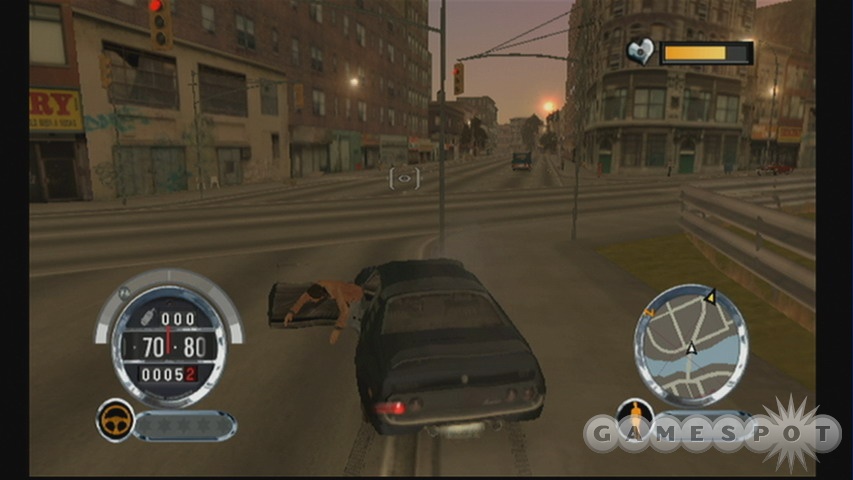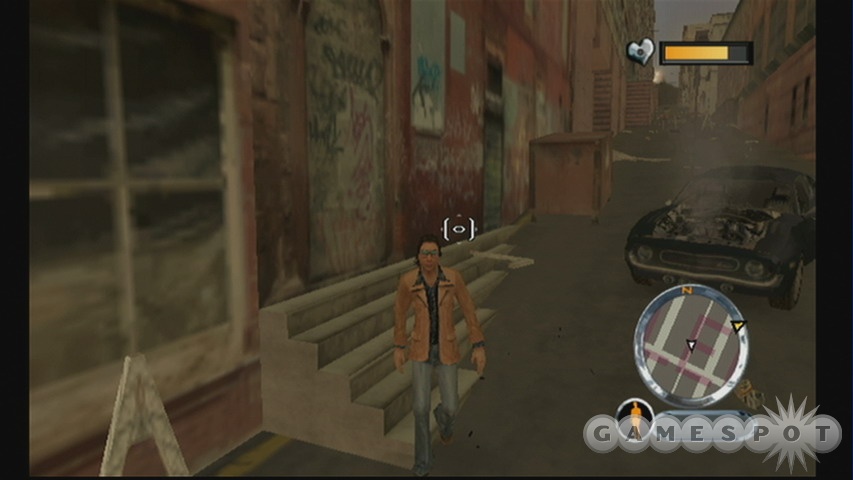Driver: Parallel Lines wasn't a good game when it came to conventional consoles over a year ago, and putting it on the Wii hasn't helped matters at all. This Grand Theft Auto clone suffers even more because it's been shoehorned onto the Wii and is saddled with some annoying control shortcomings. Not that sketchy control is the game's only problem. It's almost completely uninspired and devoid of the little things that make these sorts of games entertaining. The characters fall flat, and the story is uninteresting. Add to that some pretty drab mission design, and you've got a title that simply can't add up to a game worth playing.

The action opens in 1978. You, as an 18-year-old named TK, have moved to New York City in search of excitement. You're pretty good behind the wheel of a car, and you quickly catch on with a crew of criminals looking to make it big. This being the late '70s, "making it big" eventually turns out to mean "starting a cocaine empire." But, as these things normally go, stuff doesn't pan out quite so well for TK, and he gets locked up for 28 years. This fast-forwards the game to the present day. TK gets out of the joint in 2006 with revenge on his mind, and the story picks up from there. It's a potentially interesting premise that falls apart because none of the individual characters are very compelling or likeable in either era.
The gameplay in Driver puts you in a big, open city that's broken up into three areas by bridges. There are a few side missions, like races and repo-man jobs, which earn you money to be spent on car upgrades. But considering that the cars are as disposable as you'd expect from a game like this, spending money on engine upgrades seems like a waste of time, and consequently earning money usually isn't your goal. Instead, you'll follow the story path by taking on a variety of regular missions. Most of them are, as you might expect from a game called "Driver," focused on operating a motor vehicle. You'll get into races, collect packages, and even steal a car, fit it with a bomb, and then drive it back to where you found it so the owner will receive an explosive surprise--unless he played GTAIII, in which case he'll probably see this now-ancient mission design coming from a mile away. Some missions require you to do things on foot, which forces you to deal with the game's lackluster targeting system. The aiming and looking functions are both somehow assigned to the Wii Remote, making things skittish and more difficult to manage than they should be. You can target and fire forward out of vehicles, too, but this is only useful when you're chasing someone...which isn't all that often. Considering that you get into some pretty hot spots with lots of bullets flying your way, and that most of your enemies are crack shots, fumbling with the targeting becomes very annoying.
At least if you fail, you won't have to retreat very far. When you die or otherwise fail when on a mission, you can quickly hit a button to try again. Many of the longer missions have checkpoints, too, so you won't have to do the early parts again and again if you're having trouble with the final leg of a scenario. It's pretty handy, and cuts down on repetition.
There are a few minor police-response systems in the game that stand out because the other games in this genre handle things a little differently. Police cars drive around the world, and you can see them on your minimap, complete with Metal Gear Solid-style vision cones. Doing stuff like speeding, running a red light, or causing a collision while in the cops' vision cone activates them and raises your heat level. You actually have two different types of heat to deal with. Normally, if the cops see your car while you're in the middle of some heinous act, the heat meter for your current vehicle rises as you speed away. But if the cops see you get out of that car, the heat is all on you, and they'll chase you regardless of which vehicle you're driving. Unfortunately, the cops really aren't very difficult to avoid, and they aren't very smart either. Usually, turning down an alley in plain view is enough to completely confuse them and cause them to give up the chase. Stopping off at one of your safe havens totally resets your personal heat level, too. Cops occasionally turn up in missions to potentially give you a harder time, but just as often it seems as though you simply can't find any cops on the streets when you're on a job. Overall, the police presence is more of a hassle than anything else because it forces you to drive slow, stop at stop signs, and other "realistic" stuff that isn't entertaining in the least.

The Wii version of the game is about on par with the Xbox version of the game, and it looks OK when you're running in 480p. The frame rate is solid and the environments look pretty good, though the characters look sort of goofy when you're out of your car. There are some interesting visual tricks here and there, too, like the way the entire HUD gets redesigned and modernized when you switch from '78 to '06, or the way TK's walk animation changes from a ridiculous, swaggering strut in '78 to a toned-down, more normal-looking walk in the present day. On the audio side, the game doesn't sound very good. Most of the voice acting isn't really worth listening to at all. Music plays when you're in a vehicle, and there's a decent array of licensed tunes, but as you might expect, the '70s music is a little more entertaining than the also-ran and out-of-date-sounding stuff you hear in the game's 2006 setting.
Driver is a very by-the-numbers GTA clone. While stuff like having to obey speed laws and stop at red lights arguably makes the game more realistic, it certainly doesn't make it any more entertaining. With unexciting driving physics and lackluster on-foot control, playing Driver: Parallel Lines isn't very satisfying, and the game's monochromatic storyline isn't strong enough to make the trip worthwhile.